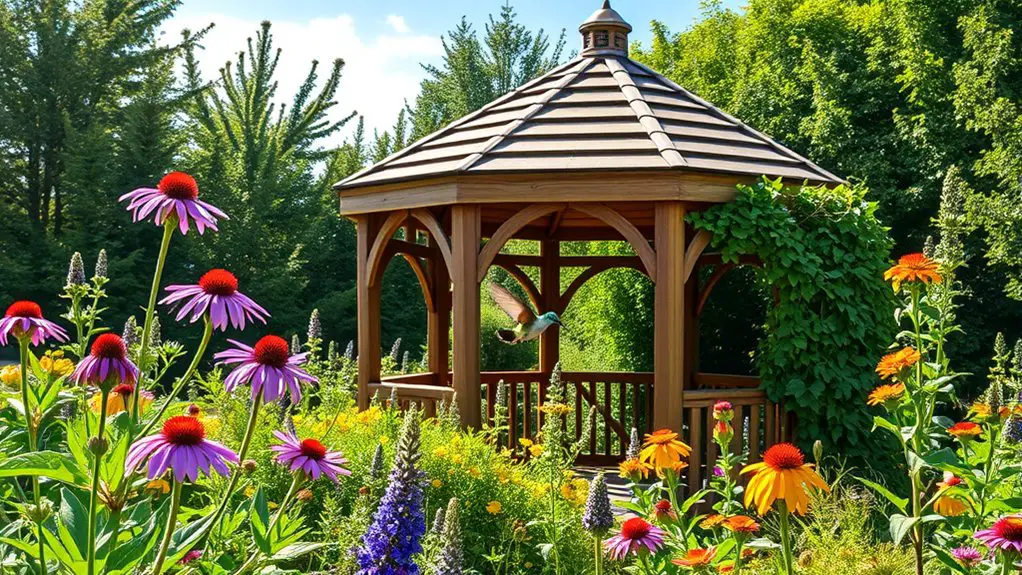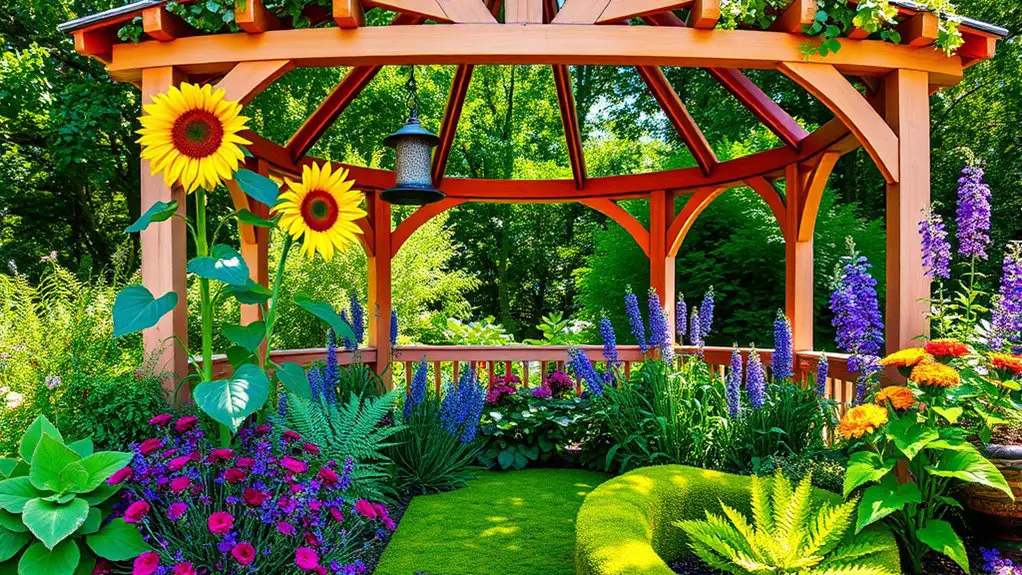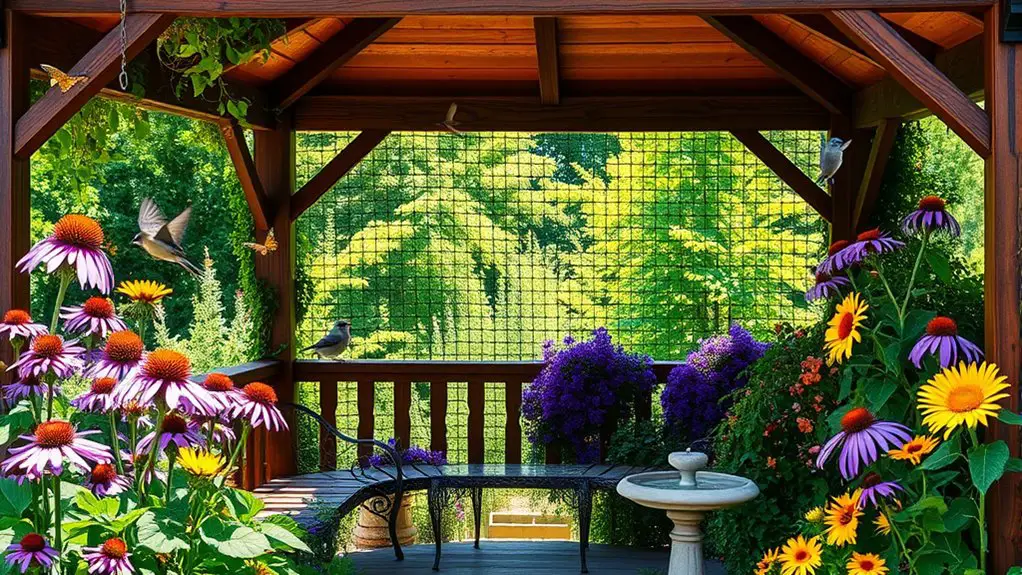To attract local wildlife to your gazebo with plants, choose native species suited to your region. These plants support pollinators and local fauna by providing essential habitat and food sources. Incorporate a variety of flowering plants that bloom across seasons to guarantee a steady supply of nectar. Additionally, consider layering plants of different heights and adding water features, like fountains or ponds. This approach creates an inviting ecosystem for diverse wildlife, and more tips await you ahead.
Choosing Native Plants for Your Gazebo

When you’re looking to attract local wildlife to your gazebo, choosing native plants is essential, as they provide the right habitat and resources for local fauna. Native plants offer numerous benefits, including enhanced biodiversity and support for local pollinators, birds, and other wildlife. They’ve adapted to your region’s specific soil conditions and climate, ensuring ideal growth without requiring excessive water or fertilizers. This local soil adaptation not only conserves resources but also reduces maintenance efforts, allowing you to enjoy your space without the burden of constant care.
Creating a Pollinator-Friendly Environment
To create a pollinator-friendly environment around your gazebo, it’s essential to incorporate a variety of flowering plants that bloom at different times throughout the season. By doing so, you’ll provide continuous food sources for bees and butterflies, fostering vibrant bee habitats and butterfly gardens right in your backyard.
Consider these three key elements:
- Diverse Plant Selection: Choose native plants that attract local pollinators, ensuring a mix of colors and shapes.
- Seasonal Blooming: Plant species that flower from early spring to late fall to keep pollinators visiting year-round.
- Water Source: Include a shallow water dish with stones for bees and butterflies to land on, as hydration is vital for their survival. Additionally, incorporating climbing plants around your gazebo can further enhance the habitat by providing shelter and attracting more diverse wildlife.
Incorporating Flowering Plants for Nectar

Incorporating a variety of flowering plants for nectar around your gazebo not only enhances its beauty but also plays an essential role in supporting local pollinators. By choosing nectar-rich blooms, you can create a vibrant ecosystem that attracts bees, butterflies, and hummingbirds. Seasonal plantings can guarantee a continuous source of food throughout the year.
Here’s a quick guide to some excellent flowering plants:
| Plant Name | Bloom Season | Nectar Attraction |
|---|---|---|
| Butterfly Bush | Summer | High for butterflies |
| Coneflower | Summer | Great for bees |
| Black-eyed Susan | Summer/Fall | Attracts various pollinators |
| Aster | Fall | Rich in late-season nectar |
| Bee Balm | Summer | Loved by hummingbirds |
Selecting Fruit-Bearing Plants for Wildlife
Selecting fruit-bearing plants for wildlife not only adds a delightful aesthetic to your gazebo but also provides essential food sources for various animals. By incorporating these plants, you’ll create a vibrant habitat that supports local ecosystems. Here are three great options to evaluate:
Enhance your gazebo with fruit-bearing plants, creating a beautiful habitat that nourishes local wildlife.
- Berry Bushes: Blueberries, raspberries, and blackberries attract birds and small mammals, offering them nutritious snacks while enhancing your garden’s beauty.
- Fruit Trees: Apple and pear trees not only provide shade but also bear delicious fruits that wildlife will flock to during the growing season.
- Edible Ground Covers: Plants like strawberries can serve dual purposes, beautifying your space while providing a feast for both you and local critters.
Designing a Layered Planting Scheme

While creating a vibrant wildlife habitat around your gazebo, designing a layered planting scheme can greatly enhance biodiversity and visual appeal. By incorporating plant diversity at various layered heights, you can attract a wider range of species. Start with taller plants or small trees to form the backdrop, providing shelter for birds and larger insects. Next, add mid-sized shrubs that offer berries and blooms for pollinators, creating an inviting space for butterflies and bees. Finally, fill in the lower layer with groundcovers and wildflowers, which not only beautify but also provide nectar and habitat for smaller creatures.
This strategic arrangement maximizes sunlight and moisture access, ensuring each layer thrives. Additionally, diverse plant species can create a more resilient ecosystem, supporting beneficial organisms and reducing pests naturally. Embrace this layered approach, and watch as your gazebo becomes a thriving hub for local wildlife.
Adding Water Features to Attract Wildlife
To attract a diverse array of wildlife, consider incorporating water features like fountains or small ponds into your gazebo area. Fountains not only provide a constant source of fresh water but also create sounds that draw birds and other creatures. Meanwhile, a well-maintained pond can support aquatic life and serve as a drinking source for various species, enhancing your garden’s biodiversity.
Choosing the Right Fountain
A well-chosen fountain can transform your gazebo into a vibrant hub for local wildlife. When selecting a fountain, consider these three key factors:
- Fountain Materials: Opt for durable materials like stone or ceramic that mimic natural water sources, attracting birds and insects.
- Fountain Styles: Choose a design that complements your gazebo’s aesthetic. Basin fountains encourage wildlife to perch and drink, while tiered options create a dynamic sound that draws more attention.
- Water Movement: Incorporate features that keep water circulating. Flowing water not only attracts wildlife but also prevents stagnation, promoting a healthy ecosystem.
Installing a Small Pond
Creating a small pond can considerably enhance your gazebo’s appeal to local wildlife, providing an important habitat for various species. A well-designed pond attracts amphibians, insects, and birds, fostering biodiversity. Start by choosing a location that receives sunlight and is easily accessible for wildlife observation. Make sure your pond is at least two feet deep to prevent algae buildup. Incorporate native plants around the edges for shelter and food. Regular pond maintenance is vital—remove debris, monitor water levels, and check for invasive species. Adding a small fountain can aerate the water and create a soothing sound, further enticing wildlife. Ultimately, your pond will become a vibrant ecosystem, enriching both your space and the local environment.
Providing Shelter and Nesting Areas
While you may think of your gazebo as simply a space for relaxation, it can also become an essential sanctuary for local wildlife when you incorporate thoughtful shelter and nesting areas. Creating sheltered corners will not only invite birds and small mammals but also provide them a safe haven. Here are three ways to enhance your gazebo for wildlife:
Transform your gazebo into a refuge for wildlife by adding shelter and nesting spaces for birds and small mammals.
- Plant Native Shrubs: Native plants offer natural nesting materials and attract local fauna.
- Install Birdhouses: Strategically place birdhouses within the gazebo to provide safe nesting spots for various bird species.
- Create Brush Piles: Piling up twigs and leaves in a sheltered corner can serve as shelter for small animals and insects. Additionally, incorporating native plants can enhance outdoor comfort by attracting beneficial wildlife, further enriching the gazebo experience.
Maintaining Your Wildlife-Friendly Garden
Maintaining a wildlife-friendly garden requires ongoing attention, as the delicate balance of your ecosystem can shift with changing seasons. To keep your garden thriving, focus on seasonal maintenance tasks. In spring, plant native species and remove invasive plants that threaten your ecosystem. During summer, guarantee your garden is hydrated while allowing for natural rainfall to support local wildlife.
Pest management is essential—consider introducing beneficial insects like ladybugs or using organic methods to deter harmful pests. In fall, prune perennials and leave some foliage for overwintering creatures.
Winter brings a time for reflection; use this season to plan for next year’s growth. Regularly observe the interactions among plants and wildlife, adjusting your practices accordingly. By dedicating time to these tasks, you’ll create a harmonious environment that supports a diverse range of species while enjoying the beauty of your garden.
Frequently Asked Questions
What Types of Wildlife Can I Expect to Attract?
You’ll likely attract various bird species, such as finches and sparrows, while also increasing insect diversity, including butterflies and bees. These creatures will enhance your outdoor experience, creating a vibrant ecosystem around your gazebo.
How Long Does It Take for Wildlife to Discover My Gazebo?
Wildlife discovery can take time and patience. Typically, you might see visitors within weeks, but it could take months for consistent activity. Factors like habitat quality and local species affect how quickly wildlife finds your gazebo.
Can I Use Non-Native Plants to Attract Wildlife?
While non-native plants might seem appealing for attracting wildlife, native plant benefits like supporting local ecosystems outweigh their allure. Invasive plant concerns can disrupt habitats, so it’s best to choose plants that naturally belong to your area.
How Can I Prevent Pests While Attracting Wildlife?
To prevent pests while attracting wildlife, use natural repellents like garlic or peppermint. Incorporate companion planting; certain plants repel harmful insects, promoting biodiversity while ensuring your garden remains a thriving, harmonious environment.
What Time of Year Is Best to Plant for Wildlife?
For best results, spring planting’s ideal for attracting wildlife. Consider seasonal factors like soil temperature and moisture; these influence plant growth and biodiversity. Timing your planting can greatly enhance your garden’s ecological appeal and habitat quality.

